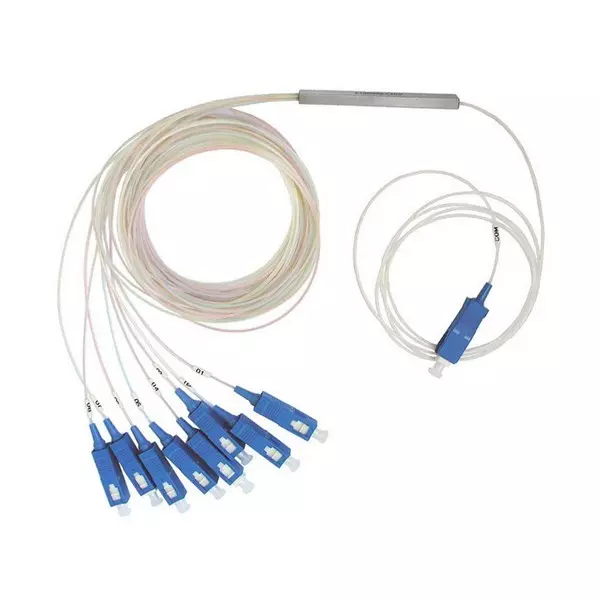Exploring Balanced and Unbalanced PLC Splitters in Telecommunication Infrastructure

Overview of Types
Function of PLC Splitters
PLC splitters, also known as fiber optic splitters, serve a critical function in telecommunication infrastructure by dividing an optical signal into multiple signals. This division process is essential for efficient signal distribution within fiber optic networks, allowing a single input to be split and distributed across multiple outputs. By performing this function, PLC splitters enable the sharing of a single optical network connection among multiple subscribers or end users. This capability is particularly valuable in passive optical networks (PON), where PLC splitters play a crucial role in ensuring that the optical signal reaches its intended destinations effectively.
Applications of PLC Splitters
The applications of PLC splitters are diverse and impactful within telecommunication infrastructure. As mentioned earlier, they are extensively used in passive optical networks (PON) to facilitate the distribution of signals from a single source to multiple endpoints. Additionally, PLC splitters are integral components in various other telecommunication setups where efficient signal distribution is required. Their versatility and effectiveness make them indispensable for ensuring seamless communication and connectivity within modern fiber optic networks.
Blockless Splitters
Blockless Splitters offer several advantages that make them a popular choice in telecommunication infrastructure. Their compact design allows for easy installation and integration into existing systems, making them a convenient and cost-effective solution for signal distribution. The space-saving nature of blockless splitters makes them ideal for environments where space is constrained, providing a practical and efficient solution for signal distribution within limited areas.
These splitters are widely used in telecommunication infrastructure due to their versatility and effectiveness. Their ability to efficiently distribute signals while occupying minimal space makes them an invaluable component in various telecommunications setups. Whether it's in a crowded urban setting or a confined indoor environment, the compact and space-saving design of blockless splitters ensures seamless signal distribution without compromising on performance.
Advantages of Blockless Splitters
Compact design for easy installation
Cost-effective solution for signal distribution
Applications of Blockless Splitters
Ideal for space-constrained environments
Widely used in telecommunication infrastructure
Balancing in Infrastructure
Importance of Balanced Splitters
Balanced splitters play a critical role in ensuring the even distribution of signals within telecommunication infrastructure. By evenly dividing the optical signal into multiple outputs, balanced splitters contribute to the optimal performance of fiber optic networks. This balance is essential for maintaining signal integrity throughout the network, preventing any disruptions or degradation in the transmission of data. The uniform distribution of signals enables each endpoint to receive an equal and consistent level of connectivity, thereby enhancing the overall efficiency and reliability of the network.
Considerations for Balanced Splitters
When incorporating balanced splitters into a cabling system design, it is crucial to consider their impact on signal distribution and overall network performance. The deployment of balanced splitters can significantly enhance the efficiency of fiber optic networks by ensuring that signals are distributed uniformly across all endpoints. Additionally, proper consideration of balanced splitters can lead to an optimized cabling system design, minimizing signal loss and maximizing the effectiveness of signal distribution within telecommunication infrastructure.

Unbalanced Splitters
Challenges of Unbalanced Splitters
Unbalanced splitters pose significant challenges in telecommunication infrastructure due to their tendency to cause uneven signal distribution, which can adversely affect network performance. The uneven distribution of signals may lead to varying levels of connectivity among endpoints, resulting in disparities in data transmission speeds and reliability. This inconsistency can ultimately impact the overall efficiency and effectiveness of the network, potentially leading to signal loss and degradation. Addressing these challenges is crucial for maintaining the integrity and optimal performance of fiber optic networks.
Mitigating Unbalanced Splitter Issues
Mitigating the issues associated with unbalanced splitters requires a proactive approach that encompasses proper installation and maintenance practices. Ensuring that unbalanced splitters are installed correctly and maintained regularly is essential for minimizing the impact of uneven signal distribution on network performance. Additionally, careful considerations for signal balancing within telecommunication infrastructure can help mitigate the challenges posed by unbalanced splitters, contributing to a more reliable and efficient fiber optic network.
Significance of Balance
Importance of Signal Balance
Maintaining balance within telecommunication infrastructure is paramount for the seamless operation of communication networks. Balanced PLC splitters play a crucial role in ensuring that signals are evenly distributed, thereby preserving the integrity of data transmission. Understanding the dynamics of signal balance and unbalance is essential for optimizing the performance of telecom networks. Properly balanced splitters contribute significantly to the overall efficiency and reliability of communication networks, making them indispensable components in modern telecommunication infrastructure.
See Also
Exploring the Applications of LC SC Duplex Fiber Optic Adapters
LC vs. SC Connectors: Choosing the Right Fiber Adapter for Your Network
The Role of Termination Boxes in FTTH Networks
About US
Follow Us
AnetFiber company's main products are indoor and outdoor optical fiber cables, outdoor waterproof pre-connected fiber-to-the-home products, PLC optical fiber splitters, optical fiber jumpers and pigtails, MTP®/MPO high-density big data product solutions, optical fiber field quick connectors and research and development molding, injection molding and production of optical fiber distribution boxes, optical fiber chassis cabinets, the market has expanded to the world, Europe, America, Asia, the Middle East and Latin America.
Address
Shenzhen City, Baoan District, Yanluo Street, Tangxiayong Community, Yangyong Industrial Road, Tonggangda New Energy Vehicle Park 406
Contacts
+86 199 2655 3586

